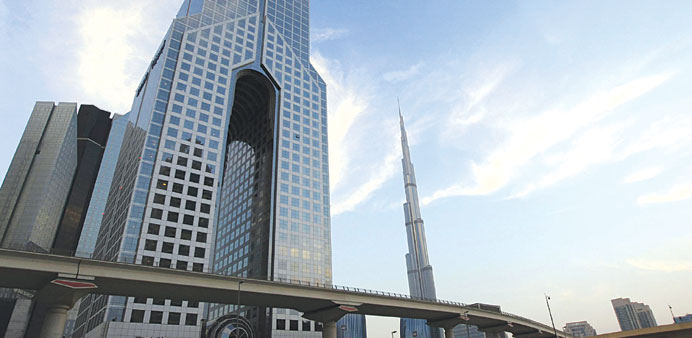The Burj Khalifa (right) is pictured next to the Dusit hotel and residences on Sheikh Zayed road in Dubai (file). Expecting Dubai to “soft land”, BofAML said tightening regional liquidity would make Dubai refinancing more challenging, but the imbalances are less pronounced than pre-2008.
The Gulf economies are expected to grow slower this year and show twin deficits on flattish hydrocarbons and softer non-oil sector, according to Bank of America Merrill Lynch (BofAML).
“The GCC (Gulf Co-operation Council) macro story is likely to have peaked if oil prices stay low for long. We expect twin deficits and weaker real GDP growth and softer non-hydrocarbon sector growth on fiscal policy prudence,” BofAML said.
The global bank has forecast the real GDP (gross domestic product) growth of 2.8% in 2015 for the GCC, slowing from 4% in 2014 on account of flattish hydrocarbon production and softer non-hydrocarbon sector activity.
In 2015, Saudi Arabia is expected to grow at 2.5%, the UAE at 2.9% and Qatar at 4.8%, it said.
On the twin deficits, BofAML estimated the aggregate fiscal deficit to be 10.1% of GDP and current account to be 3% of GDP.
Expecting capital expenditures to bear the brunt of the adjustment, based on historical experience, it said “we would expect GCC governments to attempt to maintain current spending programs. This should slow down investment growth and support consumption on a relative basis, in our view.”
The bank kept the external debt of Dubai, Abu Dhabi and Qatar at market weight as it found Dubai to have “tight spreads” given the high leverage and potential refinancing challenges.
“Abu Dhabi and Qatar’s savings cushion sovereign creditworthiness,” it said, adding “we remain underweight on Bahrain external debt as lower oil prices increase Bahrain’s fiscal strains given the still elevated fiscal breakeven oil price and with rating downgrades likely.
Expecting Dubai to “soft land”, BofAML said tightening regional liquidity would make Dubai refinancing more challenging, but the imbalances are less pronounced than pre-2008.
“The pace of growth has been more modest and the banking sector is better capitalised, more liquid, and improved its net external position versus Bank for International Settlement banks, while credit trends have been much more contained than pre-2008,” it said.
However, the bank cautioned that leverage still remains high and the external sector is exposed to a slowdown.
“As for 2015 refinancing, the Dubai World deal provides breathing room, and we do not view limitless debt difficulties as systemic. 2016 looks to be more challenging with roughly $6bn in restructured debt coming due, including at the Dubai Holding level,” it said.
Business / Business
Twin deficits: GCC slowdown seen amid flat hydrocarbons and softer non-oil sectors

